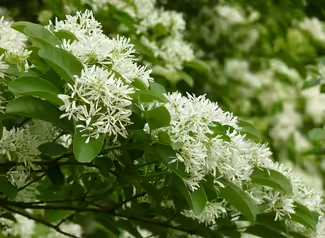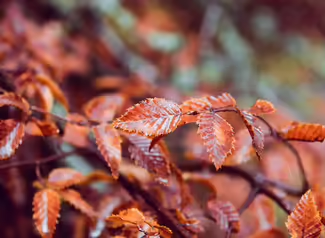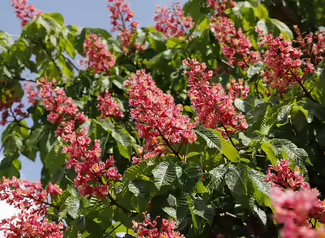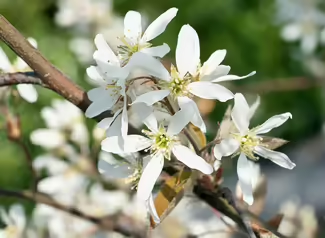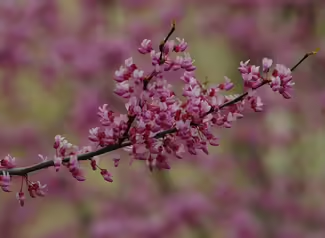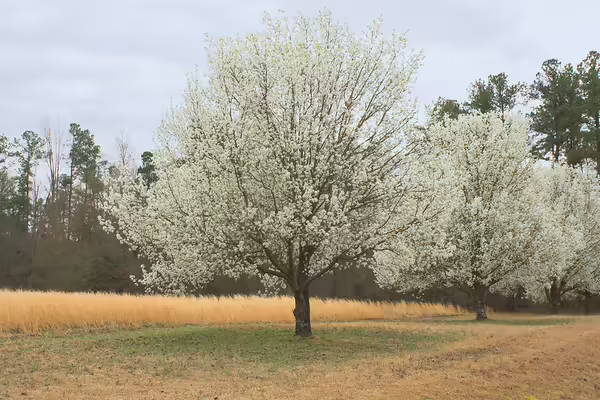
URBANA, Ill. — Now considered an invasive species, Callery pear is a widely used ornamental flowering tree with negative effects on native ecosystems. The tree is still bought, sold, and planted because it has not yet made the list of plants included in the Illinois Exotic Weed Act. Until policies are amended, educational outreach and word of mouth are the best ways to combat the use of Callery pear. What trees make good replacements for Callery pear in the landscape? Numerous Illinois native species make suitable alternatives or replacements.
American Fringetree Chionanthus virginicus
Also known as Grancy Graybeard, the American fringetree is a medium-sized deciduous tree that blooms in late spring. It is known for fragrant flower clusters with white fringe-like petals. Other features are the smooth, silver-gray bark and attractive fall foliage. Fringetree is a host plant for several insect species, and the fruit is a food source for many birds, including the cardinal, blue jay, and pileated woodpecker.
American Hornbeam Carpinus caroliniana
The American Hornbeam, also called ironwood and musclewood, is a medium-sized tree with distinctive muscle-like fluted bark and very hard wood. While not known for showy flowers, hornbeam produces subtle catkins in spring. It's valued for its unique form and attractive, doubly serrated leaves that turn a yellow-orange color in fall. Though an understory tree in its natural habitat, hornbeam tolerates a range of conditions, including clay soil and black walnut toxicity.
Red Buckeye Aesculus pavia
In late spring, red buckeye exhibits 6 to 10-inch long panicles of beautiful orange-red flowers that attract hummingbirds. These blooms give way to shiny brown seeds inside a smooth husk. The large, palmately compound leaves are a glossy green in summer and drop early in fall. Red buckeye is hardy to zone 6 and may be marginally hardy in the colder climates of northern Illinois.
Serviceberry Amelanchier spp.
Serviceberry is a small native tree that offers ornamental appeal like Callery pear. Its showy white flowers in the spring result in colorful, edible summer fruit that attracts birds and other wildlife. They are hardy to zone 4 and prefer moist, well-drained soil that is slightly acidic but tolerates many soil types in community environments. The downy serviceberry, A. arborea, offers beauty every season, and smooth shadbush, A. laevis, has very tasty fruit. Autumn Brilliance, Amelanchier x grandiflora, is a natural hybrid of A. laevis and A. arborea that is commonly used in yards and parks.
Flowering dogwood Benthamidia florida, previously Cornus florida
Flowering dogwood is another beautiful native tree with year-round seasonal interest, but don’t eat the fruit. Though it’s food for many songbirds, the bright red drupe or fruit is quite bitter to humans. Flowering dogwood blooms in spring with large white bracts appearing as large flower petals. The true flowers are small and yellow-green, inconspicuously located in the center of the bracts. Cultivated varieties boast more colorful flowers, fruit, and fall leaves. Some research suggests that cultivars of the species are not as beneficial to pollinators and other wildlife.
Eastern redbud Cercis canadensis
Eastern Redbud is a small deciduous tree with vibrant pink spring flowers that bloom directly on the branches before leaves appear. This adds a splash of color to the dull grey of early spring and is a valuable resource for many pollinators, including hummingbirds. Part shade is best in hot summer climates, but, like dogwood, it will also perform in full sun. Also, like dogwood, redbud is quite susceptible to verticillium wilt, a fungal disease that affects numerous species and for which there is no effective treatment beyond prevention.
For more on finding alternatives to the invasive Callery pear tree, connect with a location Extension office at go.illinois.edu/ExtensionOffice.
Sarah Vogel is an Illinois Extension horticulture educator for DeWitt, Macon, and Piatt counties. Gardeners Corner is a quarterly newsletter from gardening experts around the state. Each issue highlights best practices that will make your houseplants, landscape, or garden shine in any season. Join the Gardener’s Corner email list at go.illinois.edu/GCsubscribe for direct access to timely tips.
PHOTO CAPTION: Now considered an invasive species, Callery pear is a widely used ornamental flowering tree with negative effects on native ecosystems. Photo: Adobe Stock.
Illinois Extension leads public outreach for University of Illinois by translating research into action plans that allow Illinois families, businesses, and community leaders to solve problems, make informed decisions, and adapt to changes and opportunities. Illinois Extension is part of the University of Illinois Urbana-Champaign College of Agricultural, Consumer and Environmental Sciences.
